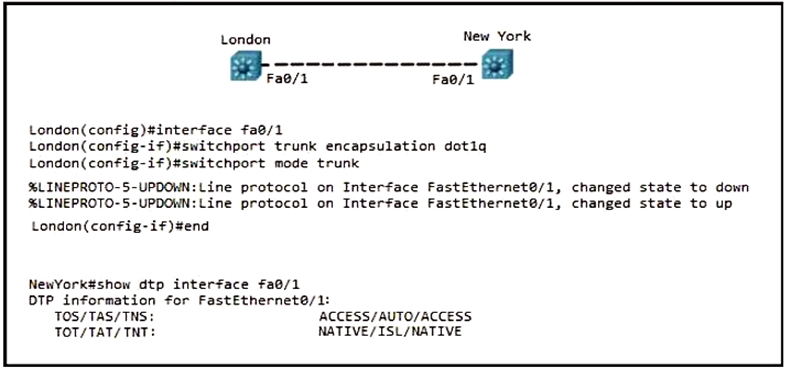
Refer to the exhibit. Communication between London and New York is down. Which command set must be applied to resolve this issue?

Refer to the exhibit. Communication between London and New York is down. Which command set must be applied to resolve this issue?
The issue is that the trunk can’t form due to a mismatch in encapsulation protocols. The exhibit shows that New York is set to use ISL encapsulation by default, while ports that need to communicate must use the same encapsulation protocol. London is configured to use dot1q encapsulation. Therefore, to address the mismatch, you must change the encapsulation method on New York to dot1q. This is achieved by the command set outlined in option C.
Has to be C. TOS = Trunk Operational Status TAS = Trunk Administrative Status TNS = Trunk Negotiated Status TOT = Trunk Operational Trunk-Encapsulation TAT = Trunk Administrative Trunk-Encapsulation TNT = Trunk Negotiated Trunk-Encapsulation Operational = What we are doing at this moment Administrative = How we configured it Negotiated = What we asked for during the negotiation TAS is configured as Auto, so if other side is trunk and this side is auto then it will form trunk. There is no need for B. If we look for trunk-encapsulation TAT, it's set for ISL. It will not work for .1q. I think you need to change encapsulation to .1q, so answer should be C.
agree. perfectly explained
Thanks for your explanation
when i come upon comments like yours, it renews my faith in humanity XOXO
C is the correct the answer because: 1. the port is auto, so it tends to be access but if it detects the other side to be trunk, it will change automatically to mode trunk, 2. The problem is the protocol is Cisco ISL, it must be changed to .1q and that's what C config does
Agreed C, more info to back this up: https://learningnetwork.cisco.com/s/question/0D53i00000Ksyty/tostastns-tottattnt
Depends on how old the platform is. Newer platforms no longer use ISL, and defaults to dot1q.
If Cisco switches are using Dynamic Trunking Protocol (DTP) between two ports, and one port is configured with the Inter-Switch Link (ISL) encapsulation, while the other port is configured with the IEEE 802.1Q (dot1q) encapsulation, the two ports will not negotiate a trunk. DTP will not be able to establish a trunk link between these two ports because ISL and dot1q are incompatible trunking encapsulation protocols. ISL is a Cisco-proprietary protocol for trunking, while dot1q is an industry-standard protocol widely used for trunking. Since they are different protocols, they cannot negotiate a trunk link using DTP. In this scenario, if you want to create a trunk between the two switches, you should configure both ports with the same trunking encapsulation protocol. If one switch is using ISL, the other switch should also use ISL. If one switch is using dot1q, the other switch should use dot1q as well. This way, they can successfully negotiate a trunk link and pass VLAN traffic between them.
A is incorrect because you are setting the trunk to nonegotiate and that's not what we want B is incorrect because it's missing Switchport mode trunk encapsulation dot1Q. C is incorrect because it's missing switchport mode trunk D is the correct answer, setting a trunk port to Dynamic Desirable will send negotiations to the other end and it will Trunk 100% of the time. Set up the Packet tracer and test it yourself, It's gonna work.
On newer platforms and codes, ISL is no longer a trunk negotiation protocol. Dot1q is now the default. On such platforms, you only need to configure the interface as switchport mode trunk.
That may be true but in this exhibit, clearly NY isn't one of those newer platforms as it has ISL configured.
You need the correct encapsulaton. Answer must be C
Its C, admin please change the answer.
for NewYork switch the DTP interface fa0/1 : TOS/TAS/TNS: ACCESS/AUTO/ACCESS TOT/TAT/TNT: NATIVE/ISL/NATIVE it shows that it is currently operating as an Access Port, in Dynamic Auto mode, and its negotiated to be an Access Port. The second line NATIVE/ISL/NATIVE. shows it is not forming or negotiating a Trunk with SW1. So to make it truly dynamic, it should put Fa1/0/1 on SW2 encapsulation type back into negotiate : NewYork(config)#int f0/1 NewYork(config)#switchport trunk encap dot1q NewYork(config)#end It can take 10 or 15 seconds for DTP to bring interfaces back up due to that 30 second time, but the interface did eventually bounce, and when it came back it is now showing : TOS/TAS/TNS: TRUNK/AUTO/TRUNK TOT/TAT/TNT: 802.1Q/NEGOTIATE/802.1Q for more details : https://loopedback.com/2017/08/26/dtp-dynamic-trunking-protocol-the-exam-information-and-a-lot-of-live-cli-output-to-demonstrate-behaviors-of-dtp/
Trunk ports run DTP automatically unless the command nonegotiate is issued. Setting the other side to dynamic desirable means that encapsulation mode and trunk status is negotiated.
NY site configured with ISL(cisco), but London use dot1.q. For me answer is C.
C is the correct answer. The remote side configured with (switchport trunk enc isl) you only need to change it to dotq.
I would select D, because: A: other side has DTP enabled, so cannot disable DTP B: mode trunk, but missing encapsulation, which will be ISL vs dot1q C: encapsulation dot1q, but missing mode trunk, it will not make the switch port trunk D: CORRECT, because both, mode trunk and encapsulation will be negotiated by DTP
CORRECTION: although London has DTP enabled but has mode trunk configured, mode trunk negotiates trunking with NewYork which is set to auto. Last thing to configure then is the encapsulation, so C is correct.
########################## NewYork(config)#int f0/1 NewYork(config)#switchport trunk encap dot1q NewYork(config)#end NewYork#
how can it be C as the command switchport mode trunk after encapsulation dot1q is missing
it´s C
ISL vs 802.1q
c is correct